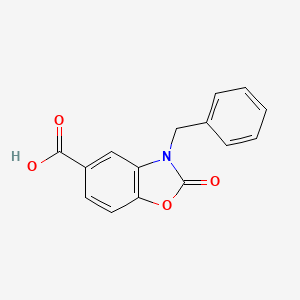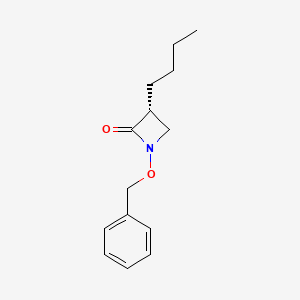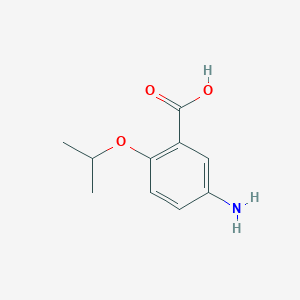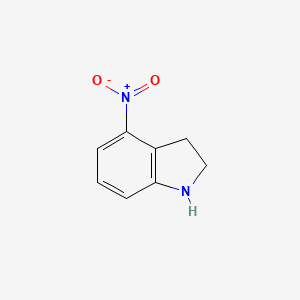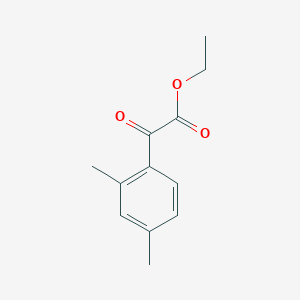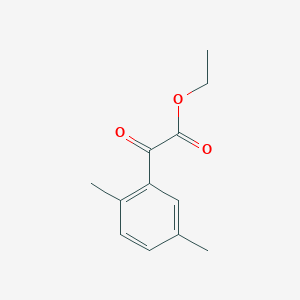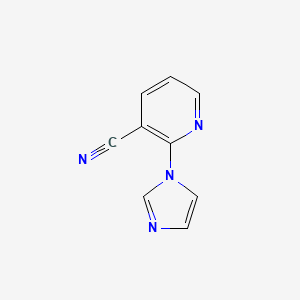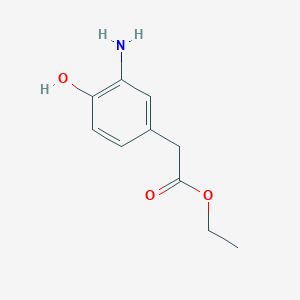![molecular formula C15H10BrClFN3O2 B1317276 5-((4-Bromo-2-chlorophenyl)amino)-4-fluoro-1-methyl-1H-benzo[d]imidazole-6-carboxylic acid CAS No. 606144-04-1](/img/structure/B1317276.png)
5-((4-Bromo-2-chlorophenyl)amino)-4-fluoro-1-methyl-1H-benzo[d]imidazole-6-carboxylic acid
描述
5-((4-Bromo-2-chlorophenyl)amino)-4-fluoro-1-methyl-1H-benzo[d]imidazole-6-carboxylic acid is a complex organic compound that belongs to the class of benzimidazole derivatives. These compounds are known for their diverse biological activities and are widely used in medicinal chemistry for the development of therapeutic agents.
准备方法
Synthetic Routes and Reaction Conditions
The synthesis of 5-((4-Bromo-2-chlorophenyl)amino)-4-fluoro-1-methyl-1H-benzo[d]imidazole-6-carboxylic acid typically involves multiple steps, starting from commercially available precursors. One common method involves the cyclization of amido-nitriles in the presence of a nickel catalyst, followed by proto-demetallation, tautomerization, and dehydrative cyclization . The reaction conditions are mild and can accommodate a variety of functional groups, including aryl halides and heterocycles .
Industrial Production Methods
Industrial production methods for this compound are not widely documented, but they likely involve similar synthetic routes with optimizations for large-scale production. These optimizations may include the use of continuous flow reactors and automated synthesis platforms to improve yield and reduce production costs.
化学反应分析
Types of Reactions
5-((4-Bromo-2-chlorophenyl)amino)-4-fluoro-1-methyl-1H-benzo[d]imidazole-6-carboxylic acid can undergo various chemical reactions, including:
Oxidation: This reaction typically involves the use of oxidizing agents such as hydrogen peroxide or potassium permanganate.
Reduction: Common reducing agents include sodium borohydride and lithium aluminum hydride.
Substitution: This compound can participate in nucleophilic substitution reactions, often using reagents like sodium methoxide or potassium tert-butoxide.
Common Reagents and Conditions
The reactions mentioned above generally require specific conditions to proceed efficiently. For example, oxidation reactions may require acidic or basic conditions, while reduction reactions often occur under anhydrous conditions to prevent side reactions.
Major Products Formed
The major products formed from these reactions depend on the specific reagents and conditions used. For instance, oxidation may yield carboxylic acids or ketones, while reduction can produce alcohols or amines.
科学研究应用
5-((4-Bromo-2-chlorophenyl)amino)-4-fluoro-1-methyl-1H-benzo[d]imidazole-6-carboxylic acid has several scientific research applications:
Chemistry: It is used as a building block for the synthesis of more complex molecules.
Medicine: It is investigated for its potential use in developing new therapeutic agents for various diseases.
Industry: The compound is used in the development of functional materials and catalysts.
作用机制
The mechanism of action of 5-((4-Bromo-2-chlorophenyl)amino)-4-fluoro-1-methyl-1H-benzo[d]imidazole-6-carboxylic acid involves its interaction with specific molecular targets and pathways. For example, it may inhibit certain enzymes or receptors, leading to the modulation of biological processes. The exact molecular targets and pathways can vary depending on the specific application and context of use .
相似化合物的比较
Similar Compounds
- Methyl 5-(4-bromo-2-chlorophenylamino)-4-fluoro-1H-benzo[d]imidazole-6-carboxylate .
Selumetinib: 5-(4-Bromo-2-chlorophenylamino)-4-fluoro-N-(2-hydroxyethoxy)-1-methyl-1H-benzo[d]imidazole-6-carboxamide.
Uniqueness
Compared to similar compounds, 5-((4-Bromo-2-chlorophenyl)amino)-4-fluoro-1-methyl-1H-benzo[d]imidazole-6-carboxylic acid stands out due to its unique combination of substituents, which can confer distinct biological activities and chemical reactivity. This uniqueness makes it a valuable compound for research and development in various scientific fields.
属性
IUPAC Name |
6-(4-bromo-2-chloroanilino)-7-fluoro-3-methylbenzimidazole-5-carboxylic acid | |
|---|---|---|
| Source | PubChem | |
| URL | https://pubchem.ncbi.nlm.nih.gov | |
| Description | Data deposited in or computed by PubChem | |
InChI |
InChI=1S/C15H10BrClFN3O2/c1-21-6-19-14-11(21)5-8(15(22)23)13(12(14)18)20-10-3-2-7(16)4-9(10)17/h2-6,20H,1H3,(H,22,23) | |
| Source | PubChem | |
| URL | https://pubchem.ncbi.nlm.nih.gov | |
| Description | Data deposited in or computed by PubChem | |
InChI Key |
XAAPQRFIXGDKPZ-UHFFFAOYSA-N | |
| Source | PubChem | |
| URL | https://pubchem.ncbi.nlm.nih.gov | |
| Description | Data deposited in or computed by PubChem | |
Canonical SMILES |
CN1C=NC2=C1C=C(C(=C2F)NC3=C(C=C(C=C3)Br)Cl)C(=O)O | |
| Source | PubChem | |
| URL | https://pubchem.ncbi.nlm.nih.gov | |
| Description | Data deposited in or computed by PubChem | |
Molecular Formula |
C15H10BrClFN3O2 | |
| Source | PubChem | |
| URL | https://pubchem.ncbi.nlm.nih.gov | |
| Description | Data deposited in or computed by PubChem | |
DSSTOX Substance ID |
DTXSID20582176 | |
| Record name | 5-(4-Bromo-2-chloroanilino)-4-fluoro-1-methyl-1H-benzimidazole-6-carboxylic acid | |
| Source | EPA DSSTox | |
| URL | https://comptox.epa.gov/dashboard/DTXSID20582176 | |
| Description | DSSTox provides a high quality public chemistry resource for supporting improved predictive toxicology. | |
Molecular Weight |
398.61 g/mol | |
| Source | PubChem | |
| URL | https://pubchem.ncbi.nlm.nih.gov | |
| Description | Data deposited in or computed by PubChem | |
CAS No. |
606144-04-1 | |
| Record name | AZ-133266637 | |
| Source | ChemIDplus | |
| URL | https://pubchem.ncbi.nlm.nih.gov/substance/?source=chemidplus&sourceid=0606144041 | |
| Description | ChemIDplus is a free, web search system that provides access to the structure and nomenclature authority files used for the identification of chemical substances cited in National Library of Medicine (NLM) databases, including the TOXNET system. | |
| Record name | 5-(4-Bromo-2-chloroanilino)-4-fluoro-1-methyl-1H-benzimidazole-6-carboxylic acid | |
| Source | EPA DSSTox | |
| URL | https://comptox.epa.gov/dashboard/DTXSID20582176 | |
| Description | DSSTox provides a high quality public chemistry resource for supporting improved predictive toxicology. | |
| Record name | AZ-133266637 | |
| Source | FDA Global Substance Registration System (GSRS) | |
| URL | https://gsrs.ncats.nih.gov/ginas/app/beta/substances/D67NVR9LE7 | |
| Description | The FDA Global Substance Registration System (GSRS) enables the efficient and accurate exchange of information on what substances are in regulated products. Instead of relying on names, which vary across regulatory domains, countries, and regions, the GSRS knowledge base makes it possible for substances to be defined by standardized, scientific descriptions. | |
| Explanation | Unless otherwise noted, the contents of the FDA website (www.fda.gov), both text and graphics, are not copyrighted. They are in the public domain and may be republished, reprinted and otherwise used freely by anyone without the need to obtain permission from FDA. Credit to the U.S. Food and Drug Administration as the source is appreciated but not required. | |
Synthesis routes and methods
Procedure details













体外研究产品的免责声明和信息
请注意,BenchChem 上展示的所有文章和产品信息仅供信息参考。 BenchChem 上可购买的产品专为体外研究设计,这些研究在生物体外进行。体外研究,源自拉丁语 "in glass",涉及在受控实验室环境中使用细胞或组织进行的实验。重要的是要注意,这些产品没有被归类为药物或药品,他们没有得到 FDA 的批准,用于预防、治疗或治愈任何医疗状况、疾病或疾病。我们必须强调,将这些产品以任何形式引入人类或动物的身体都是法律严格禁止的。遵守这些指南对确保研究和实验的法律和道德标准的符合性至关重要。
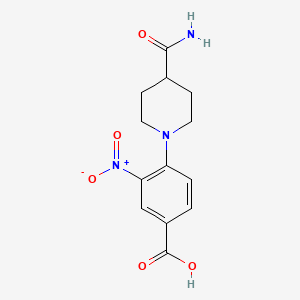
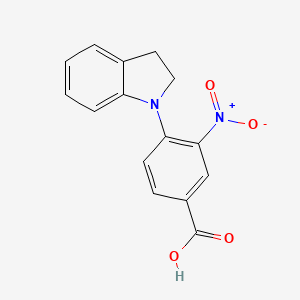
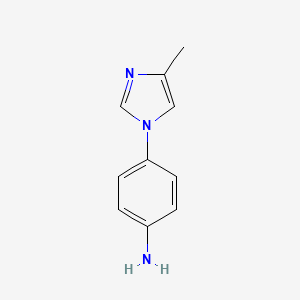
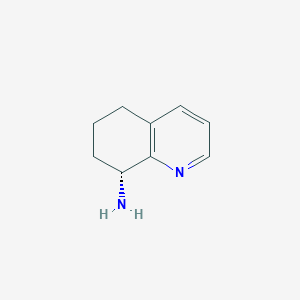
![3-[(1,2-Benzisothiazol-3-ylcarbonyl)amino]-4-methylbenzoic acid](/img/structure/B1317202.png)
